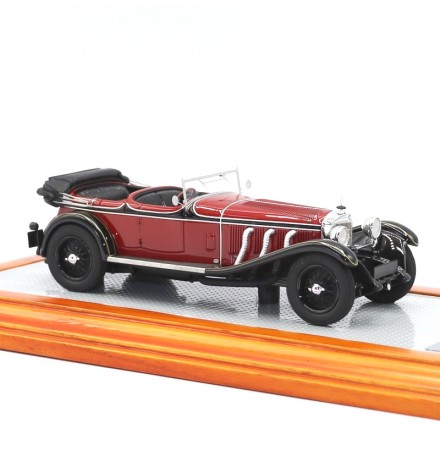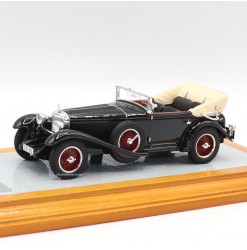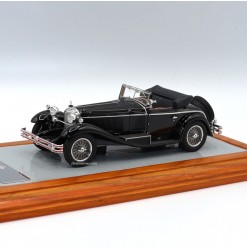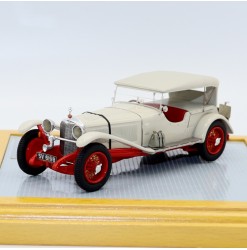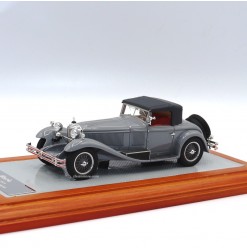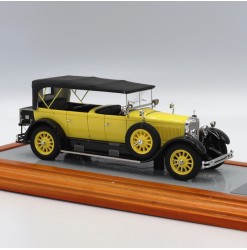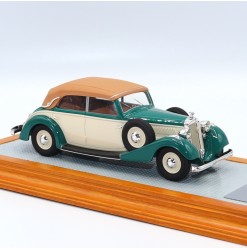Sir Peter Ustinov, actually Peter Alexander Freiherr von Ustinov, was born on April 16th , 1921, in Swiss Cottage, (London), United Kingdom, the son of Nadezhda Leontievna (née Benois) and Jona Freiherr von Ustinov. He died on March 28th , 2004, at the age of 82 in Genolier, (Canton de Vaud) in Switzerland.
Peter Ustinov's father, Jona Freiherr von Ustinov, was of German, Russian, Polish, Ethiopian and Jewish descent. Peter's paternal grandfather was Baron Plato von Ustinov, a Russian nobleman, and his grandmother was Magdalena Hall, scion of a mixed German-Ethiopian-Jewish family.
Ustinov's mother, Nadezhda Leontyevna Benois, called Nadia, was a painter and ballet designer of French, German, Italian and Russian descent. Her father, Leon Benois, was an Imperial Russian architect and owner of Leonardo da Vinci's "Benois Madonna" painting, which now hangs in the Hermitage Museum in Saint Petersburg.
Their paternal ancestor, Jules-César Benois, was the confectioner to the Duke of Montmorency in France, but he left the country in 1794 during the French Revolution for Saint Petersburg, where he became the confectioner to Tsarina Maria Fiodorovna (the former Sophie-Dorothée Augusta Luisa of Württemberg), wife of the Russian Tsar Paul I.
Peter Ustinov's father Jona worked as a press officer at the German embassy in London in the 1930s and was a reporter for a German news agency.
In 1935, two years after Adolf Hitler came to power in Germany, Jona von Ustinov began working for the British secret service MI5 and became a British citizen.
In all likelihood, Jona von Ustinov was the MI6 spy known as "U35".
Although as a child he was unaware of what was going on behind closed doors in his parents' drawing room, Sir Peter Ustinov recounts in his autobiography that his father hosted secret meetings of high-ranking British and German officials in his London home.
Known to many for his role as Agatha Christie's Hercule Poirot, and (among many others) for his role in the movies Quo Vadis or in Viva Max, Sir Peter Alexander Ustinov, CBE, FRSA, was a British actor, filmmaker and writer. An internationally renowned raconteur, he was a fixture on television talk shows and lecture series for much of his career. As an intellectual and diplomat, he held various academic posts, he was a "Goodwill Ambassador" for UNICEF and President of the World Federalist Movement.
In 1999, together with his son Igor, he founded the "Peter Ustinov Foundation" in Frankfurt am Main, whose aim is to create a common world of tolerance, open minds and mutual respect. His family background, upbringing, and life experiences gave Sir Peter Ustinov his cosmopolitan outlook that set him against any kind of nationalism and extremism.
Peter Ustinov also had a lifelong hobby: automobiles! Since his childhood, his parents, who, as he himself admits in his autobiography, understood absolutely nothing about motorisation, were at times rather concerned about their son's well-being. From the moment he woke up to the moment he went to bed at night, he thought he was a car, and he knew exactly which one: an "Amilcar"!
His first car, however, was not an Amilcar but a Fiat 500, which he bought for 200 pounds, quite a nice sum at the time, especially for a young private during the Second World War.
Those who understand English can't help but be amused by an audio recording from 1958 that Ustinov made in a single recording session. It is his "reportage" on the "Grand Prix of Gibraltar" with his interviews (as a sports reporter) of Mr. Altbauer, and with, among others, the racing drivers Jose Julio Fandango, Girling Foss, Wolfram v. Grips, Karl Fling, and Bill Dill, complete with all the accents. They are joined by the Wildfowl race car, made lighter for the race by removing the ashtray and installing a smaller clock. (Grand Prix connoisseurs may have recognised Juan Manuel Fangio, Stirling Moss, Phil Hill etc.) ...
The recording is hilarious mischief from start to finish, all in Peter Ustinov's own voice, engine noises included! At the same time, however, the recording is also an ironic critique of the circus surrounding the Monaco GP.
The long-playing record of the “Grand Prix of Gibraltar” can still be found with a bit of luck, the CD released in 2003 is hard to find too, but you can enjoy all the fun nonsense on "You Tube". Go to “Riverside Records "The Grand Prix of Gibraltar" – YouTube”
Peter Ustinov was a car enthusiast who appreciated buying and collecting rare cars, especially cars with character (in his opinion,
character was the most important of all qualities in a car), but he did not limit himself to one particular brand. He owned, among other things, an 11.3-litre V12 Hispano-Suiza (a birthday present from his second wife; it was stolen in 1989), a Delage convertible, an Aston Martin DB 2/4, which he treasured, an Alvis Speed Twenty, an early Maserati Quattroporte, a Jowett Jupiter, several BMWs, and, yes, a small 600cc DAF "Variomatic", which he prized because the little car, driven slowly, made it through any deep snow where all others got stuck. However, he told an interviewer one day, chuckling, that "many of today's small cars reminded him of bidets".
He also owned for a time a Mercedes-Benz Type 680 S, which has been on display for years during Ustinov’s lifetime - and still is - at the "National Motor Museum" in Beaulieu, Hampshire, UK. He once said about this 680 S: "It was very fast, very dangerous and had cable-operated brakes. When it rained, the brake pedal sent a message to one of the wheels, which rather reluctantly sent a message to another wheel, and so on. Each wheel reacted at a different time, so that one drove at 100 miles per hour across the whole road.”
This Mercedes 680 S, with "body by Gangloff"…
…or more accurately "body in the style of Gangloff", or "bodywork after Gangloff" has a somewhat strange history. The right-hand drive Mercedes-Benz 26/120/180 hp type 680S, ordered on June 4 th , 1928, with commission number 40637, chassis number 35952, and engine number 71808 was sold as a mobile chassis on September 4
th , 1928 by British Mercedes (London) to a Mr. Dowding in London. Merely one month later, on October 6 th, 1928, the chassis changed hands, the new owner being a Mr. J. Lloyds living in St. Neots, 95 km north of London.
Then, in October 1950 we find the car for sale at the dealer C. Arnold in Northampton (East Midlands, England) for 230 GBP. Apparently, the car did not find a buyer, because already in December 1950 it is for sale again, this time at Chipstead Motors in London SW3, and is advertised as a red two-seater "bargain" in "excellent condition".
There it waits for a buyer until mid-1951. Finally, in June 1951, the 680S with the number plate YX5964 was purchased by Peter Ustinov.
The car, as it was bought by Peter Ustinov, and as the car was exhibited at the "Montagu Motor Museum" in Beaulieu until the 1970s, basically consisted of a rolling Mercedes 680S chassis with a dilettante homemade body from the "A-pillar" to the rear of the car. No pictures of the rear of the car are available or existing. It appears and looks as if plain metal panels were simply riveted together. Who made it and when remains a mystery.
In 1953 the car is taken to the workshop for the fitting of a new starter motor. Comment: Car in poor condition, amateur bodywork. The car is now painted white with red mudguards.
In 1955 the car is loaned by Peter Ustinov to the "Montagu Motor Museum" in Beaulieu, Hampshire, Great Britain.
In August 1955 the car is on display in the museum. Comment: Bodywork, paintwork, and polish: very poor. Subsequently, various works (repair and maintenance) were carried out on the car from the 1960s to the 1970s.
In 1976 Peter Ustinov formally transferred ownership of the 680S to the "National Motor Museum" (formerly "Montagu Motor Museum"), in Beaulieu.
Shortly after the car became the complete property of the museum, restoration of the 680S began in 1976. At the same time, it was decided to give the car a body that would be appropriate and worthy of the car. Given the condition of the car, I was told by the Beaulieu Museum, the subject of a new body had been raised as early as the 1950s and discussed again and again over the following two decades. It was finally decided to rebuild the 680S with a so-called "Dual Coach Phaeton" body (in German: Tourer) by Gangloff, as the Geneva coachbuilder produced them around 1928. A picture of a Mercedes 680S with Gangloff bodywork was used as inspiration.
The order went to Rod Jolley Coachbuilding, in Lymington, Hampshire (England). The replica was based solely on numerous photographs and not on technical drawings or an existing vehicle. The restored 680S with its new body was finally completed around 1980. Quite correctly, the museum describes the car as follows: "A copy of one of the three bodies in "The Car of Kings" was made by Rod Jolley in the mid1980s and placed on the chassis of a Mercedes-Benz (680S) once owned by Peter Ustinov." Years later, when Rod Jolley had the opportunity to examine at close quarters one of the two other surviving Gangloff-bodied 680S, owned by Arturo Keller and restored in the USA, Rod Jolley noticed some mistakes in the body he had made for Ustinov's car, due solely to the lack of available measurements.Mistakes or no mistakes, Rod Jolley's work is worthy of note when one considers that only photographs led to a result that is hardly, and for a "nonspecialist" likely not at all distinguishable from an original Gangloff body.
Aside from this, however, the question may arise whether the "Ustinov" car on exhibit at the "National Motor Museum" in Beaulieu has anything at all to do with Sir Peter from a historical point of view. Wouldn't it have been more authentic to restore the "soapbox" body to its original condition, along with the chassis and engine, and exhibit it? Of course, there can be no absolutely clear answer to this question. Certainly, the museum exhibit looks completely different from the car that Peter Ustinov owned for about five years in the 1950s. Moreover, the new Gangloff body was only started after the car had been transferred to the museum by Ustinov. And yet the car with the Gangloff body was undoubtedly Peter Ustinov's car, because according to custom and definition, the chassis number determines the year of manufacture and the type of car. Consequently, the 680S “Dual Phaeton” touring car that stands in the museum is the same car as the two-seater with the riveted sheet metal body, about whose problematic distribution of the brake pressure by the cable Sir Peter complained with humour. But to be accurate, one should not actually speak of a Gangloff body here, because it is 100% a replica, but of a body "in the style of Gangloff" or "in the manner of Gangloff" or "body after Gangloff". Today, in 2022, Sir Peter Ustinov's 680S, painted red and black as well, typically also "in the style of Gangloff", stands as a permanent exhibit in the "Cars of the Stars" section of the National Motor Museum in Beaulieu.
Ilario has done it again… …
a perfectly produced 1/43rd scale model of the Peter Ustinov Mercedes-Benz 680S (1928) with chassis number 35952 and Gangloff-style bodywork. There is nothing to say about the model except that you can't find anything better. Its quality is on the same level as the quality of the models produced by EMC, the studio of Kijv in Ukraine, which had to stop its production due to circumstances, even if only temporarily, one can only hope.
My thanks for their invaluable contribution to this Newsletter to:
Markus Kern, MTK Fahrzeugtechnik GmbH, (Germany); Patrick Collins, National Motor Museum, Beaulieu, Hampshire, (England); Bundesarchiv; Alamy. Portrait of Sir Ustinov on page 2 photographed by Allan Warren.









